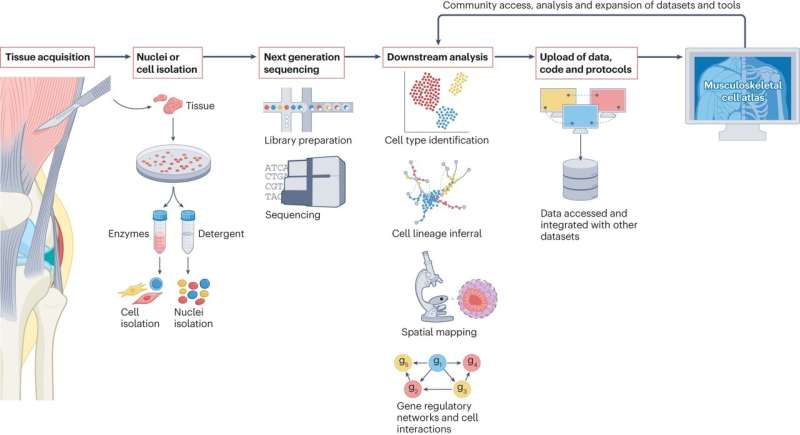This article has been reviewed according to Science X's editorial process and policies. Editors have highlighted the following attributes while ensuring the content's credibility:
fact-checked
trusted source
proofread
Researchers are building a cellular map of the musculoskeletal system

NDORMS researchers are leading the development of a roadmap, published in Nature Reviews Rheumatology, that provides a blueprint for building a single-cell resolution map of the human musculoskeletal system. The ambitious endeavor forms part of the international Human Cell Atlas, and aims to identify and spatially locate every cell within the human body.
Musculoskeletal disorders are very common and their prevalence is increasing due to the growing population around the world. Therefore this detailed reference dataset of the cells in our musculoskeletal system will be critical to both understanding normal musculoskeletal function and identifying the cellular basis for disease. It will lay the foundations for the development of new approaches to treating diseases of the joints, soft tissues and bone.
Dr. Mathew Baldwin, clinical lead of the Musculoskeletal Bionetwork of the Human Cell Atlas, says, "A representative, freely-accessible, reference dataset of healthy musculoskeletal tissue is a once-in-a-generation resource. Against this foundation the international community will unravel the transcriptional landscapes that define musculoskeletal aging, repair, disease and treatment response."
Professor Adam Cribbs, computational lead for the project, states, "The efficacy of this roadmap hinges on the robustness and scalability of computational pipelines. Achieving a comprehensive atlas necessitates meticulous annotation of cells across diverse tissues. We offer strategic guidance and resources to optimize this critical process."
Associate Professor Sarah Snelling added, "The musculoskeletal system makes up one third of adult human body weight and is incredibly diverse—with hard tissue like bone and soft tissues like cell-rich muscle and cell-poor cartilage.
"In the roadmap we have highlighted the challenges the community faces in working with such tissues, and described the key considerations that the musculoskeletal community should bear in mind when embarking on atlasing efforts. Critically, there is a fundamental need for open sharing of protocols, code and know-how to ensure musculoskeletal maps are delivered efficiently, effectively and accessibly for all researchers globally."
NDORMS has established itself as a hub in musculoskeletal cell atlasing with expertise and publications that span the cartography of musculoskeletal tissues including tendon, capsule, bone, muscle and synovium across the human lifespan in both U.K. and global populations.
More information: Mathew Baldwin et al, A roadmap for delivering a human musculoskeletal cell atlas, Nature Reviews Rheumatology (2023). DOI: 10.1038/s41584-023-01031-2




















